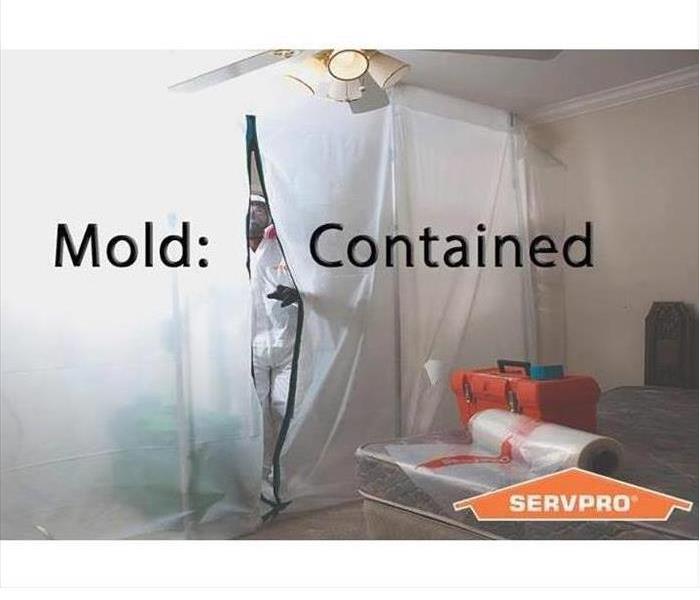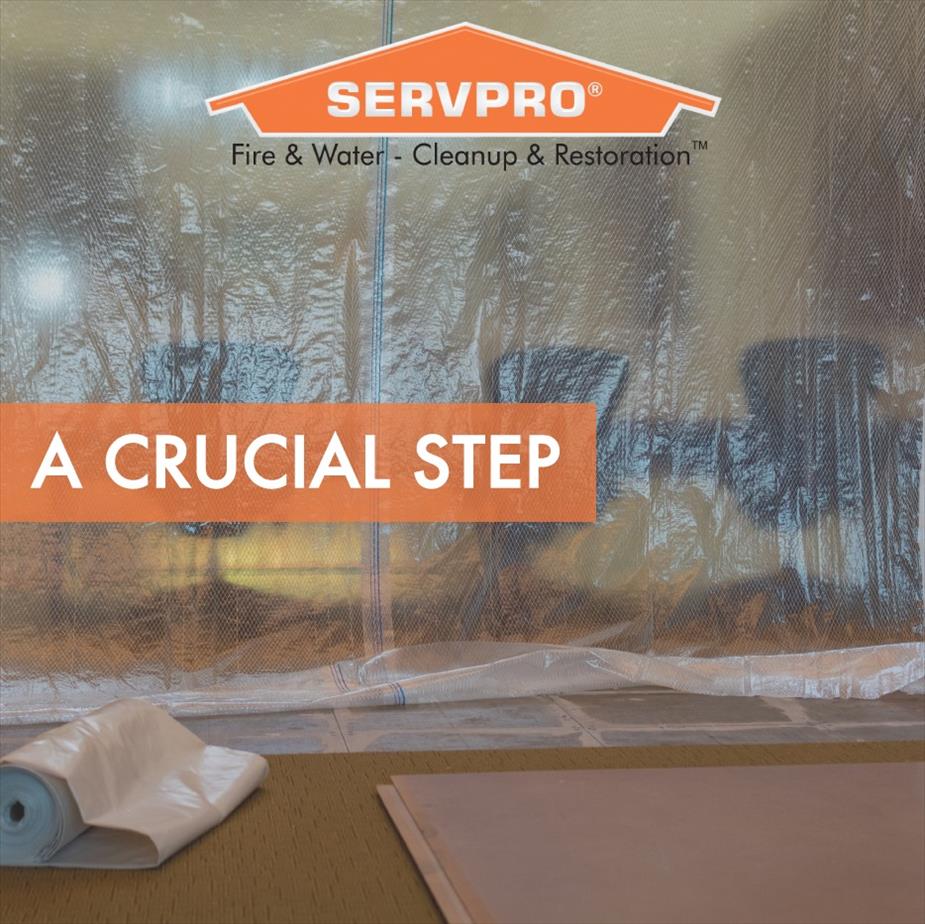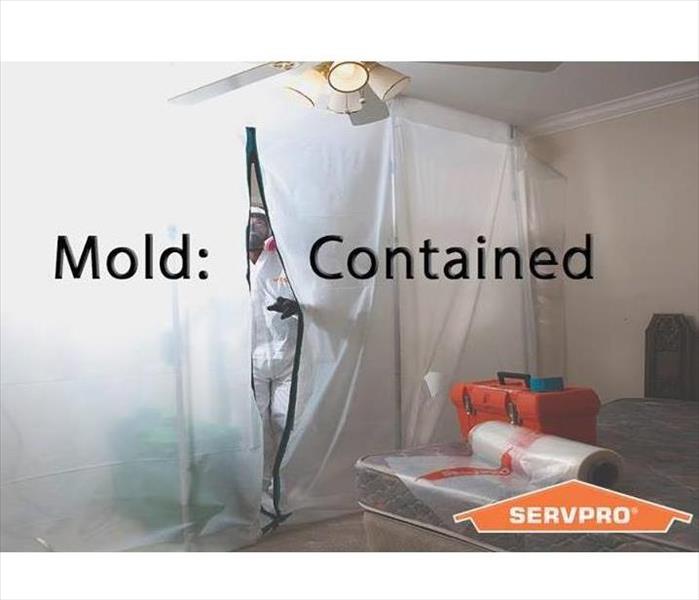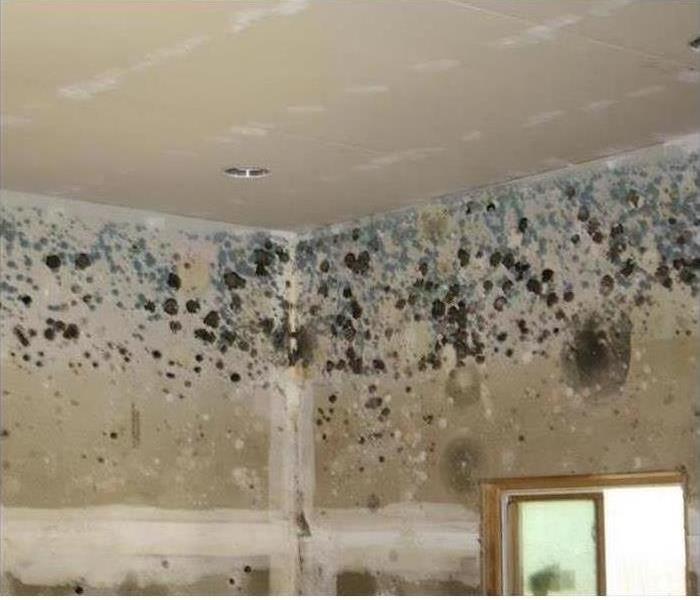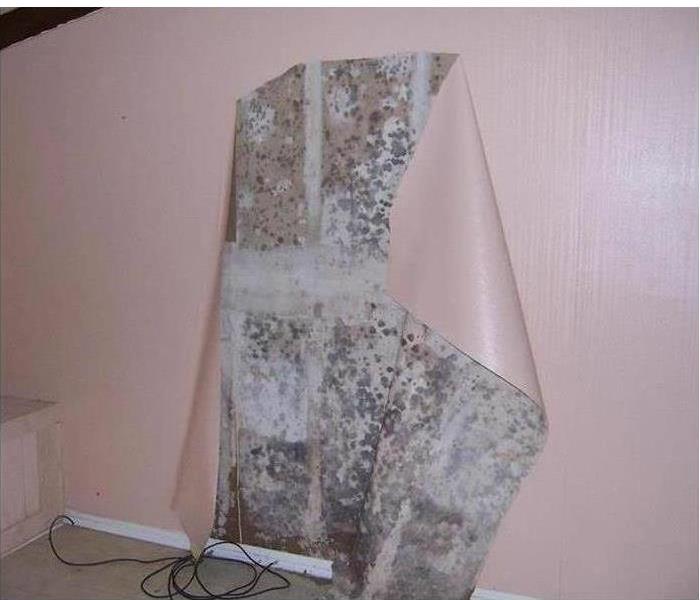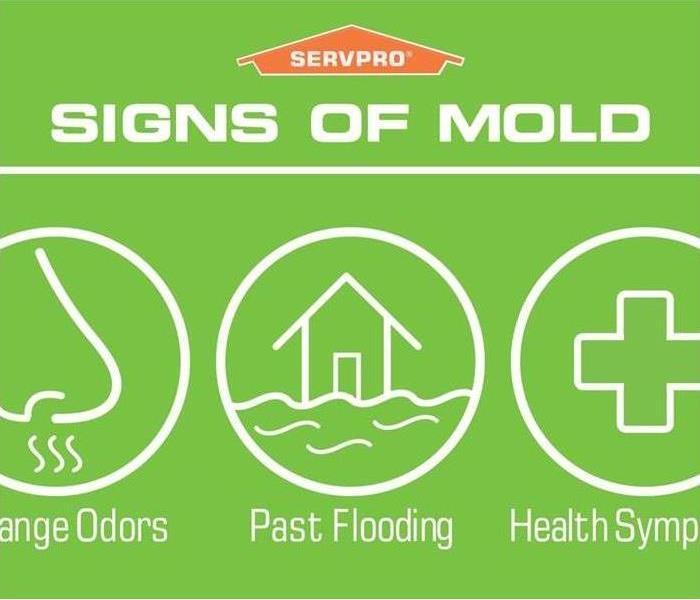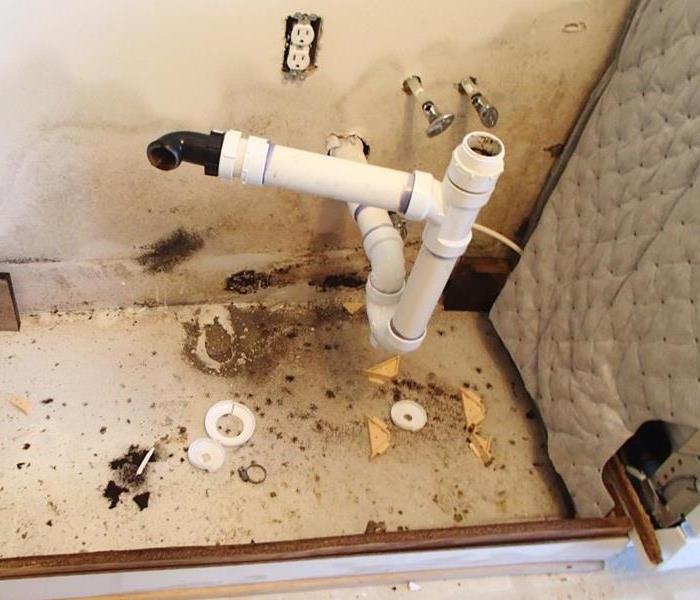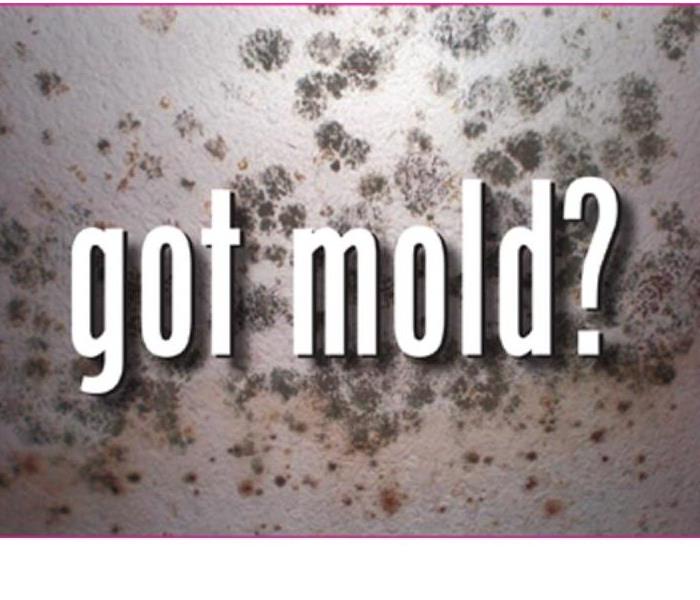Recent Mold Remediation Posts
Mold Growth Facts
2/1/2022 (Permalink)
Microscopic mold spores naturally occur almost everywhere, both outdoors and indoors. This makes it impossible to remove all mold from a home or business. Therefore, mold remediation reduces the mold spore count back to its natural or baseline level. Some restoration businesses advertise “mold removal” and even guarantee to remove all mold, which is a fallacy. Consider the following mold facts:
- Mold is present almost everywhere, indoors and outdoors.
- Mold spores are microscopic and float along in the air and may enter your home through windows, doors, or AC/heating systems or even hitch a ride indoors on your clothing or a pet.
- Mold spores thrive on moist Mold spores can quickly grow into colonies when exposed to water. These colonies may produce allergens and irritants.
- Before mold remediation can begin, any sources of water or moisture must be addressed. Otherwise, the mold may return.
- Mold often produces a strong, musty odor and can lead you to possible mold problem areas.
- Even higher-than-normal indoor humidity can support mold growth. Keep indoor humidity below 45 percent.
If your home or business has a mold problem, we can inspect and assess your property and use our specialized training, equipment, and expertise to remediate your mold infestation.
If you see any signs of mold call SERVPRO® of Suffolk/Smithfield/Franklin today at 757-934-8404.
Mold Growth & Containment
2/15/2021 (Permalink)
Microscopic mold spores naturally occur almost everywhere, both outdoors and indoors. This makes it impossible to remove all mold from a home or business. Therefore, mold remediation reduces the mold spore count back to its natural or baseline level. Some restoration businesses advertise “mold removal” and even guarantee to remove all mold, which is a fallacy. Consider the following mold facts:
- Mold is present almost everywhere, indoors and outdoors.
- Mold spores are microscopic and float along in the air and may enter your home through windows, doors, or AC/heating systems or even hitch a ride indoors on your clothing or a pet.
- Mold spores thrive on moist Mold spores can quickly grow into colonies when exposed to water. These colonies may produce allergens and irritants.
- Before mold remediation can begin, any sources of water or moisture must be addressed. Otherwise, the mold may return.
- Mold often produces a strong, musty odor and can lead you to possible mold problem areas.
- Even higher-than-normal indoor humidity can support mold growth. Keep indoor humidity below 45 percent.
If your home or business has a mold problem, we can inspect and assess your property and use our specialized training, equipment, and expertise to remediate your mold infestation.
If you see any signs of mold call SERVPRO® of Suffolk/Smithfield/Franklin today at 757-934-8404.
Safety Tips for Suspected Mold
2/15/2021 (Permalink)
If you see visible mold, do not disturb it. You can inadvertently spread the mold infestation throughout your home. When mold is disturbed, the mold can release microscopic mold spores that become airborne and can circulate inside your home.
What to Do:
- Stay out of affected areas.
- Turn off the HVAC system and fans.
- Contact SERVPRO of Suffolk/Smithfield/Franklin for mold remediation services.
What Not to Do:
- Don’t touch or disturb the mold.
- Don’t blow air across any surfaces with visible or suspected mold growth.
- Don’t attempt to dry the area yourself.
- Don’t spray bleach or other disinfectants on the mold.
About Our Mold Remediation Services
SERVPRO of Suffolk/Smithfield/Franklin specializes in mold cleanup and restoration, in fact, it’s a cornerstone of our business. Our crews are highly trained restoration professionals that use specialized equipment and techniques to properly remediate your mold problem quickly and safely.
If You See Signs of Mold, Call Us Today – SERVPRO of Suffolk/Smithfield/Franklin 757-934-8404
Mold Growth
2/3/2020 (Permalink)
Microscopic mold spores naturally occur almost everywhere, both outdoors and indoors. This makes it impossible to remove all mold from a home or business. Therefore, mold remediation reduces the mold spore count back to its natural or baseline level. Some restoration businesses advertise “mold removal” and even guarantee to remove all mold, which is a fallacy. Consider the following mold facts:
- Mold is present almost everywhere, indoors and outdoors.
- Mold spores are microscopic and float along in the air and may enter your home through windows, doors, or AC/heating systems or even hitch a ride indoors on your clothing or a pet.
- Mold spores thrive on moist Mold spores can quickly grow into colonies when exposed to water. These colonies may produce allergens and irritants.
- Before mold remediation can begin, any sources of water or moisture must be addressed. Otherwise, the mold may return.
- Mold often produces a strong, musty odor and can lead you to possible mold problem areas.
- Even higher-than-normal indoor humidity can support mold growth. Keep indoor humidity below 45 percent.
If your home or business has a mold problem, we can inspect and assess your property and use our specialized training, equipment, and expertise to remediate your mold infestation.
If you see any signs of mold call SERVPRO® of Suffolk/Smithfield/Franklin today at 757-934-8404.
Safety Tips When You Suspect Mold
2/3/2020 (Permalink)
If you see visible mold, do not disturb it. You can inadvertently spread the mold infestation throughout your home. When mold is disturbed, the mold can release microscopic mold spores that become airborne and can circulate inside your home.
What to Do:
- Stay out of affected areas.
- Turn off the HVAC system and fans.
- Contact SERVPRO of Suffolk/Smithfield/Franklin for mold remediation services.
What Not to Do:
- Don’t touch or disturb the mold.
- Don’t blow air across any surfaces with visible or suspected mold growth.
- Don’t attempt to dry the area yourself.
- Don’t spray bleach or other disinfectants on the mold.
About Our Mold Remediation Services
SERVPRO of Suffolk/Smithfield/Franklin specializes in mold cleanup and restoration, in fact, it’s a cornerstone of our business. Our crews are highly trained restoration professionals that use specialized equipment and techniques to properly remediate your mold problem quickly and safely.
If You See Signs of Mold, Call Us Today – SERVPRO of Suffolk/Smithfield/Franklin 757-934-8404
Mold Hiding Behind Wallpaper
2/1/2019 (Permalink)
Mold behind wallpaper is a big health concern. To get rid of the mold you must remove the wallpaper. First and foremost remove the wallpaper safely by wetting it with a wetting agent and water. But first, wear a good cartridge-type respirator.
When removing mold behind wallpaper safely wet it first. Even if the wallpaper removes dry still wet it
A simple dust or particulate mask won't offer adequate protection. Also, wear gloves and goggles, remember safety first. In a garden type sprayer add the wetting agent and water for easy application.
Using the sprayer to wet the wallpaper down will reduce the mold spores from becoming airborne. Even if the wallpaper removes dry still wet it first. Move slowly and deliberately so you don't stir up spores as you work.
Once the wallpaper is removed from the walls the next step is to wash the walls down with a water and bleach solution. This should remove the mold from the walls if it is just surface mold. If the walls are soft and spongy the mold may have penetrated deeper into the wall.
One way to tell if the walls are totally saturated with mold you can take a utility knife and cut a small square out of the wall and look at the back side of the square. If there is mold behind the wall then you should replace the walls. If you plan on wallpapering again use a Nonwoven wallpaper so you will never get mold behind wallpaper again. Nonwoven wallpapers can breathe, unlike vinyl wallpapers.
Mold Removal/Remeditaion
2/1/2019 (Permalink)
Any home or business can quickly become infested with mold with the introduction of a water source, like a roof or plumbing leak. Mold can spread throughout the property in as little as 48-72 hours and can produce allergens and irritants that have the potential to cause other health effects.
If you suspect that your home or business has a mold problem, SERVPRO Franchise Professionals can inspect and assess your property. If mold is found, they have the training, equipment, and expertise to handle the situation.
SERVPRO Franchise Professionals
- Provide 24/7 Emergency Service
- Highly Trained Water Restoration Specialists
- Faster to Any Size Disaster
- A Trusted Leader in the Restoration Industry with over 1,700 Franchises
If You See Signs of Mold, Call SERVPRO of Suffolk/Smithfield/Franklin 757-934-8404
Mold Prevention Tips
4/9/2018 (Permalink)
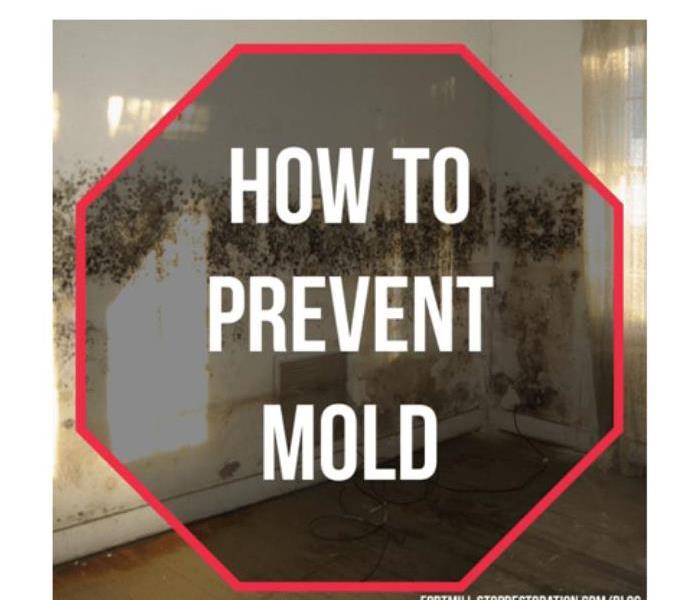
Mold. The very sound of the word is enough to make a person cringe.
Yes, mold can be good-- it's essential in making brie and penicillin, for example, but it can also be very, very bad, especially when it grows undetected in your home.Some Facts About Mold
Mold spores spread easily and cannot be completely eradicated. Mold can grow anywhere: on carpet, clothing, food, paper and even in places you can't see, such as the back of drywall, areas inside walls around leaking or condensing pipes, or above ceiling tiles. Not only is a mold problem difficult and costly to fix, but mold can also produce allergens and irritants (and rarely, toxins) that may compromise your health. So what can you do if you're concerned about mold growing on a property? The best approach is preventing mold before it becomes a problem. And the key to mold prevention is simple: moisture control. Mold Prevention Tips
Click below for nine ways to curb moisture indoors, and the mold that thrives on it.
9 Ways to Curb Indoor Moisture and Prevent Mold:
1. Identify problem areas and correct them. You can't mold-proof a property, but you can make it mold-resistant. Do an audit of the property: where are the problem areas? Does the basement flood? Do you notice frequent condensation on an upstairs window? Is there a water stain on the ceiling from a persistent leak? Preventing mold from growing or spreading might be as simple as ripping up carpet in a damp basement, installing mold-resistant products, or repairing damaged gutters. Or it may be a matter of major excavation and waterproofing. Whatever the case, address the problem now. It might cost some money up front, but it will surely be more costly down the road if mold continues to grow unchecked.
2. Dry wet areas immediately. Mold can't grow without moisture, so tackle wet areas right away. Seepage into the basement after a heavy rainfall, accumulation from a leaky pipe, even a spill on the carpet should be dried within 24 to 48 hours. If you've experienced a flood, remove water-damaged carpets, bedding, and furniture if they can't be completely dried. Even everyday occurrences need attention: don't leave wet items lying around the house, and make sure to dry the floor and walls after a shower. Don't leave wet clothes in the washing machine, where mold can spread quickly. Hang them to dry — preferably outside or in areas with good air circulation.
3. Prevent moisture with proper ventilation. It may be that your routine domestic activities are encouraging the growth of mold in the property. Make sure an activity as simple as cooking dinner, taking a shower, or doing a load of laundry doesn't invite mold by providing proper ventilation in your bathroom, kitchen, laundry room, and any other high-moisture area. Vent appliances that produce moisture — clothes dryers, stoves — to the outside (not the attic). Use AC units and dehumidifiers (especially in humid climates), but make sure they don’t produce moisture themselves by checking them periodically and cleaning them as directed by the manufacturer. Your energy-efficient property may be holding moisture inside, so open a window when cooking or washing dishes or showering, or run an exhaust fan.
4. Equip the property with mold-resistant products. Building a new home or renovating an old one? Use mold-resistant products like mold-resistant drywall or mold-resistant Sheetrock, and mold inhibitors for paints. Traditional drywall is composed of a gypsum plaster core pressed between plies of paper. Mold-resistant drywall is paperless — the gypsum core is covered in fiberglass, making the surface highly water-resistant. Moisture-resistant drywall is especially valuable in areas prone to wetness, such as bathrooms, laundry rooms, basements, and kitchens. Not only is traditional drywall more susceptible to mold than the paperless kind, but it is also difficult to rid of mold, and removal and replacement can be expensive. Mold-resistant gypsum board is also available; the core of the drywall is developed in such a way to prevent moisture absorption, and thus prevent mold growth.
5. Monitor humidity indoors. The EPA recommends keeping indoor humidity between 30 and 60 percent. You can measure humidity with a moisture. You'll also be able to detect high humidity by simply paying attention to potential problem areas of the property. Telltale signs of excessive humidity include condensation on windows, pipes, and walls. If you notice condensation, dry the surface immediately and address the source of moisture. (For example, turn off a humidifier if water appears on the inside of nearby windows.)
6. Direct water away from the property. If the ground around the property isn't sufficiently sloped away from the foundation, water may collect there and seep into your crawlspace or basement.
7. Clean or repair roof gutters. A mold problem might be a simple matter of a roof that is leaking because of full or damaged gutters. Have your roof gutters cleaned regularly and inspected for damage. Repair them as necessary, and keep an eye out for water stains after storms that may indicate a leak.
8. Improve airflow in your home. According to the EPA, as temperatures drop, the air is able to hold less moisture. Without good air flow in a property, that excess moisture may appear on your walls, windows and floors. To increase circulation, open doors between rooms, move furniture away from walls, and open doors to closets that may be colder than the rooms they’re in. Let fresh air in to reduce moisture and keep mold at bay.
9. Keep mold off household plants. They're beautiful and help keep your indoor air clean — and mold loves them. The moist soil in indoor plants is a perfect breeding ground for mold, which may then spread to other areas of your house. Instead of getting rid of your plants, try adding a bit of Taheebo tea to the water you give to your houseplants. The oil of this tree, which withstands fungi even in rainforests, helps hinder mold growth in plant soil and can be found at natural food stores.
Finally, educate yourself on your region's climate — be it the cold and wet Northeast, the hot and wet South, the hot and dry Southwest, or the cold and dry West — and how it responds to moisture. There is no one-size-fits-all solution when it comes to mold prevention. Knowing what works for your climate and your home is an important first step.
Moisture Control is Key to Mold Control
4/9/2018 (Permalink)
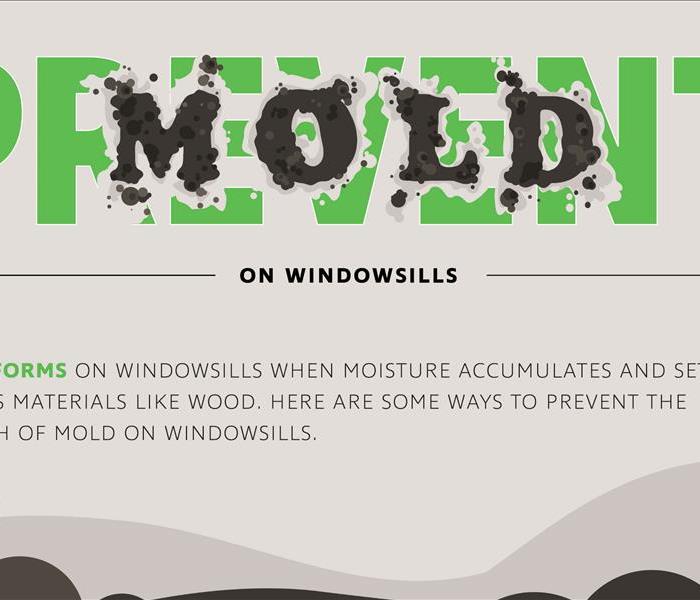
- Keep humidity levels as low as you can—no higher than 50%--all day long. An air conditioner or dehumidifier will help you keep the level low. Humidity levels change throughout the day as changes occur in the moisture in the air and the air temperature, so check the humidity levels more than once a day.
- If you see condensation or moisture collecting on windows, walls or pipes ACT QUICKLY to dry the wet surface and reduce the moisture/water source. Condensation can be a sign of high humidity.
- Be sure your home has enough ventilation. Use exhaust fans, which vent outside your home in the kitchen and bathroom. Make sure your clothes dryer vents outside your home.
- Fix any leaks in your home’s roof, walls, or plumbing so mold does not have moisture to grow.
- Clean up and dry out your home thoroughly and quickly (within 24–48 hours) after flooding.
- Remove or replace carpets and upholstery that have been soaked and cannot be dried promptly. Consider not using carpet in rooms or areas like bathrooms or basements that may have a lot of moisture.
Call SERVPRO of Suffolk/Smithfield/Franklin to remediate your mold growth. 757-934-8404
Moisture Control is Key to Mold Control
4/9/2018 (Permalink)
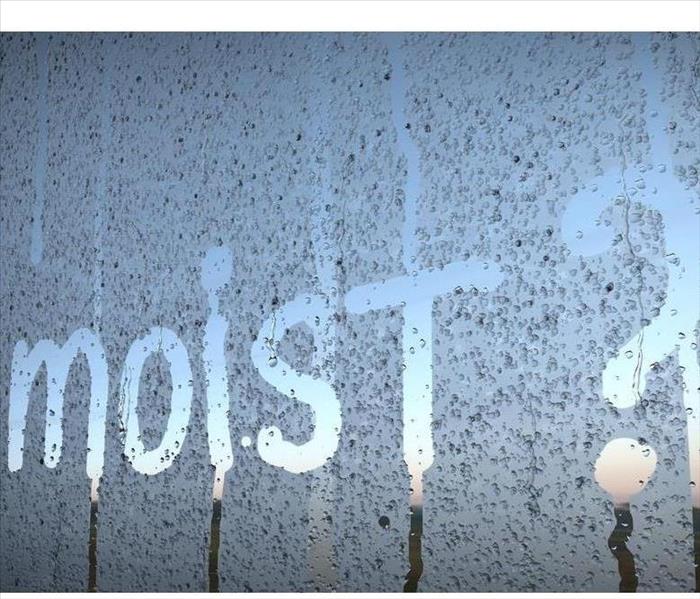
- Keep humidity levels as low as you can—no higher than 50%--all day long. An air conditioner or dehumidifier will help you keep the level low. Humidity levels change throughout the day as changes occur in the moisture in the air and the air temperature, so check the humidity levels more than once a day.
- If you see condensation or moisture collecting on windows, walls or pipes ACT QUICKLY to dry the wet surface and reduce the moisture/water source. Condensation can be a sign of high humidity.
- Be sure your home has enough ventilation. Use exhaust fans, which vent outside your home in the kitchen and bathroom. Make sure your clothes dryer vents outside your home.
- Fix any leaks in your home’s roof, walls, or plumbing so mold does not have moisture to grow.
- Clean up and dry out your home thoroughly and quickly (within 24–48 hours) after flooding.
- Remove or replace carpets and upholstery that have been soaked and cannot be dried promptly. Consider not using carpet in rooms or areas like bathrooms or basements that may have a lot of moisture.
Call SERVPRO of Suffolk/Smithfield/Franklin to remediate your mold growth. 757-934-8404
Mold Overview
3/21/2018 (Permalink)
Mold can grow anywhere that there is moisture and normally you can see or smell if you have a mold problem. It always needs three things to grow; water or moisture, a food source, and time. Mold usually appears to be fuzzy, with discolored patches that can be slimy, accompanied by a musty odor. If the mold is not visible, it is commonly found behind or underneath carpets, walls, wallpaper, and cabinets. Sources that can lead to mold are flooding, roof leaks, indoor plumbing leaks, humidifiers, damp basements and crawlspaces, steam from your bathroom or kitchen, and outdoor drainage problems.
Exposure to mold can cause health issues including headaches, coughing, itchy/watery eyes, wheezing and difficulty breathing, skin irritation, and sinus congestion. You are more susceptible to these health issues if you currently have a respiratory condition or a compromised immune system. Mold cleanup starts with controlling the moisture problem and identifying and correcting the source of the water/dampness. Call us here at SERVPRO of Suffolk/Smithfield/Franklin and we will be happy to answer any questions and assist you in remediating your mold issues. 757-934-8404
Typical Mold Causes in Hampton Roads area
3/21/2018 (Permalink)
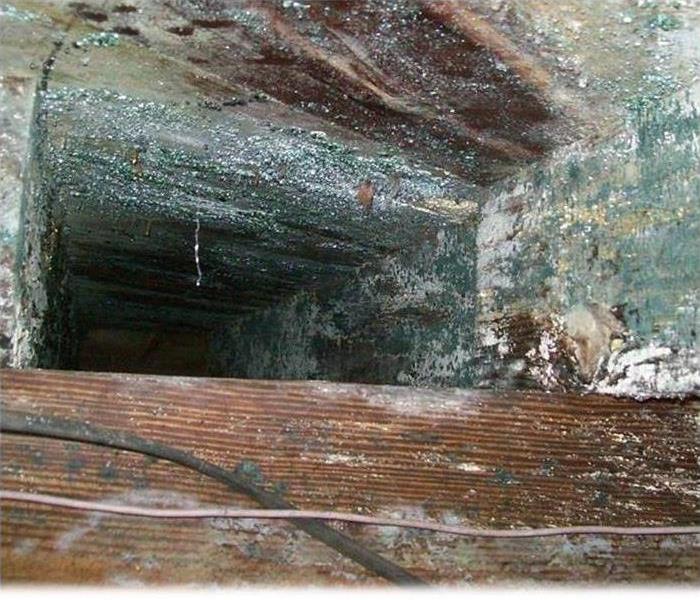 Mold hidden in a crawl space
Mold hidden in a crawl space
Mold is often the unseen enemy within our homes or businesses. Slyly, it finds an ideal nook that it calls home, and from there it can gradually grow and expand its reach. And because it comes upon us unidentified, if left unchecked, Mold can lead to deadly consequences, not just for the structure but its inhabitants too. Chronically ill family members, young children, the elderly and even the family pets, are not spared from the effects of Mold.
The textbook Mold home
Mold is very particular about where it resides. Homeowners won’t find it on a windowsill that’s bright with sunlight. Nor will you see it on floors and tiles that you walk on daily and vacuum and mop daily. However, even if most of the home is airy, filled with natural and artificial light, and cleaned often, there are sources inside your home that can allow Mold to flourish:
Indoor Humidity Levels
Climates that are extremely humid can lead to indoor humidity levels rising. On the other extreme, homeowners living with low indoor humidity levels tend to power up their humidifiers to seek relief. Other sources of indoor humidity include:
Mold needs indoor humidity levels to be slightly higher than 55% to take root. So whether you use a humidifier or a dehumidifier, make sure the humidity levels inside your home never surpass the 55% level.
Condensation Causes Mold
Cold surfaces can create condensation in your home. Condensation collects on cold metal pipes as well as on cold concrete floors, even if there is carpet over the top, and on walls. Places like these where condensation occurs are prime spots for mold growth.
Indoor leaks
Leaking roofs, pipes and appliances (washing machines, dishwashers, water heaters) are another source of house Mold. Hidden pipes (behind walls and floors) can sometimes host Mold for many years, allowing it to spread throughout the home, before the telltale signs (discoloration, damp patches, and odor) of Mold begin to appear.
The Mold Theme
By now, readers may have grasped on to the fact that the common sources of Mold explored above have a common theme. Can you guess what that is? If you guessed Dampness, then you are right. Anywhere there’s unchecked dampness within the house, Mold finds a home. And the best way to protect yourself is to continually inspect and observe every part of the home, especially rarely used or lightly trafficked areas.
If you have questions or are concerned about potential mold in your home or office, please contact SERVPRO of Suffolk/Smithfield/Franklin at 757-934-8404.
Mold and Wallpaper
2/14/2018 (Permalink)
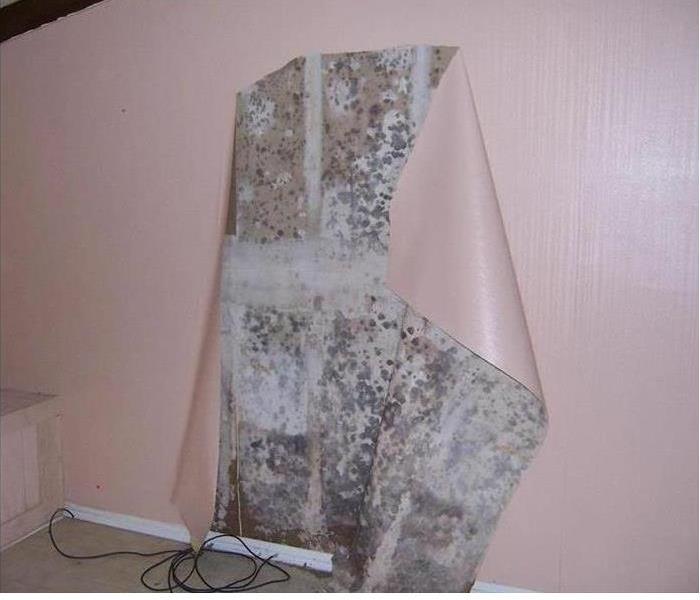 SERVPRO of Suffolk/Smithfield/Franklin
SERVPRO of Suffolk/Smithfield/Franklin
Mold behind wallpaper is a big health concern. To get rid of the mold you must remove the wallpaper. First and foremost remove the wallpaper safely by wetting it with a wetting agent and water. But first, wear a good cartridge-type respirator.
When removing mold behind wallpaper safely wet it first. Even if the wallpaper removes dry still wet it
A simple dust or particulate mask won't offer adequate protection. Also, wear gloves and goggles, remember safety first. In a garden type sprayer add the wetting agent and water for easy application.
Using the sprayer to wet the wallpaper down will reduce the mold spores from becoming airborne. Even if the wallpaper removes dry still wet it first. Move slowly and deliberately so you don't stir up spores as you work.
Once the wallpaper is removed from the walls the next step is to wash the walls down with a water and bleach solution. This should remove the mold from the walls if it is just surface mold. If the walls are soft and spongy the mold may have penetrated deeper into the wall.
One way to tell if the walls are totally saturated with mold you can take a utility knife and cut a small square out of the wall and look at the back side of the square. If there is mold behind the wall then you should replace the walls. If you plan on wallpapering again use a Nonwoven wallpaper so you will never get mold behind wallpaper again. Nonwoven wallpapers can breathe unlike vinyl wallpapers.
Mold Removal and Remediation
2/14/2018 (Permalink)
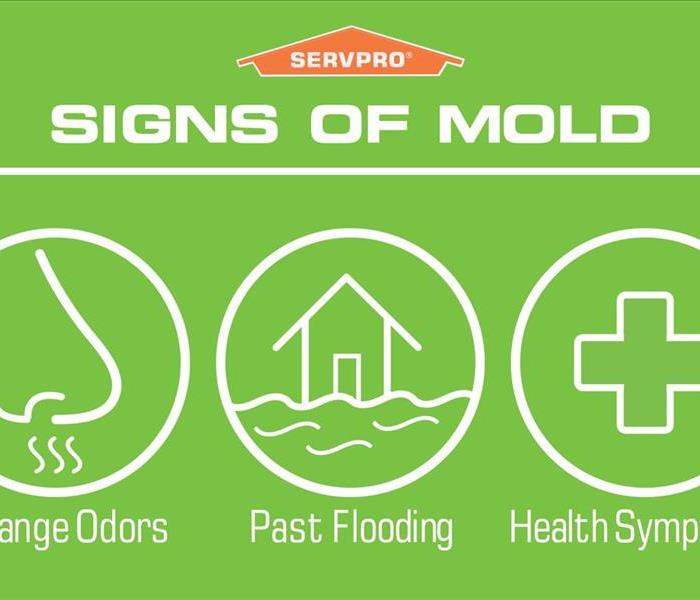 Mold signs
Mold signs
Any home or business can quickly become infested with mold with the introduction of a water source, like a roof or plumbing leak. Mold can spread throughout a property in as little as 48-72 hours and can produce allergens and irritants that have the potential to cause other health effects.
If you suspect that your home or business has a mold problem, SERVPRO Franchise Professionals can inspect and assess your property. If mold is found, they have the training, equipment, and expertise to handle the situation.
SERVPRO Franchise Professionals
- Provide 24/7 Emergency Service
- Highly Trained Water Restoration Specialists
- Faster to Any Size Disaster
- A Trusted Leader in the Restoration Industry with over 1,700 Franchises
If You See Signs of Mold, Call SERVPRO of Suffolk/Smithfield/Franklin 757-934-8404
Safety Tips To Follow If You Suspect Mold
2/23/2017 (Permalink)
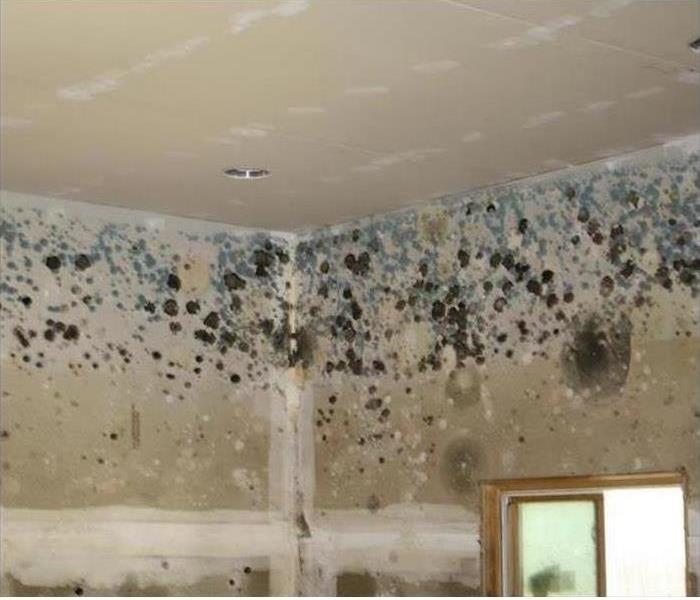 Be careful! Without proper training, you could be spreading mold throughout your home!
Be careful! Without proper training, you could be spreading mold throughout your home!
If you see visible mold, do not disturb it. You can inadvertently spread the mold infestation throughout your home. When mold is disturbed, the mold can release microscopic mold spores which become airborne and can circulate inside your home.
What to Do:
- Stay out of affected areas.
- Turn off the HVAC system and fans.
- Contact SERVPRO of Suffolk/Smithfield/Franklin for mold remediation services.
What Not to Do:
- Don’t touch or disturb the mold.
- Don’t blow air across any surfaces with visible or suspected mold growth.
- Don’t attempt to dry the area yourself.
- Don’t spray bleach or other disinfectants on the mold.
About Our Mold Remediation Services
SERVPRO of Suffolk/Smithfield/Franklin specializes in mold cleanup and restoration, in fact, it’s a cornerstone of our business. Our crews are highly trained restoration professionals that use specialized equipment and techniques to properly remediate your mold problem quickly and safely.
If You See Signs of Mold, Call Us Today – SERVPRO of Suffolk/Smithfield/Franklin 757-934-8404
Mold Can Spread Through A Home Or Business In As Little As 48 Hours
1/23/2017 (Permalink)
Microscopic mold spores naturally occur almost everywhere, both outdoors and indoors. This makes it impossible to remove all mold from a home or business. Therefore, mold remediation reduces the mold spore count back to its natural or baseline level. Some restoration businesses advertise “mold removal” and even guarantee to remove all mold, which is a fallacy. Consider the following mold facts:
- Mold is present almost everywhere, indoors and outdoors.
- Mold spores are microscopic and float along in the air and may enter your home through windows, doors, or AC/heating systems or even hitch a ride indoors on your clothing or a pet.
- Mold spores thrive on moist Mold spores can quickly grow into colonies when exposed to water. These colonies may produce allergens and irritants.
- Before mold remediation can begin, any sources of water or moisture must be addressed. Otherwise, the mold may return.
- Mold often produces a strong, musty odor and can lead you to possible mold problem areas.
- Even higher-than-normal indoor humidity can support mold growth. Keep indoor humidity below 45 percent.
If your home or business has a mold problem, we can inspect and assess your property and use our specialized training, equipment, and expertise to remediate your mold infestation.
If you see any signs of mold call SERVPRO® of Suffolk/Smithfield/Franklin today at 757-934-8404.





 24/7 Emergency Service
24/7 Emergency Service
